We decided on placing an implant in the upper left 4 position of a male English patient after taking a panorama x-ray. His tooth had been extracted 3 months previously, the space was relatively fresh. The implant: Pitt Easy V-TPS. 4*10. We gave him a medicine pack (Dalacin antibiotics and Cataflam painkillers), and ice-gel pack.
One of our Irish patients had previously lost two front teeth which we replaced with implants 3 months ago. Today we are already fitting the abutments. In order to protect the restoration we have recommended producing a bite raising nightguard which the patient has agreed to. Therefore we also took impressions for the bite raising nightguard. Because this can be produced in a short space of time, it fits into the patient’s stay in Hungary.
After missing teeth for a long time, our Danish patient will receive new teeth in positions upper right 4 and 6 with the help of implants. Following the sinus lift we placed the implants, and gave the patient antibiotics and painkillers (Dalacin C and Cataflam). The patient did not require a temporary restoration. In the next stage – in 4 months time – the patient will receive their teeth.
A 63 year old female patient wants implants in positions upper right 3, 5 and 6, because teeth have been missing in these positions for a long time. The lady’s sinus cavity was dilated thus the bone layer needed to support the implants is too thin.
An American female patient presented with multiple missing teeth and an unremarkable resorbtion in the jaw ridge. In order to be able to place implants in positions 23,24,25,26 it was necessary to carry out a minimal sinus lift. The sinus lift is a surgical treatment which we usually carry out with local anaesthetic. In the case of this patient we used BioOss, a bone replacement material of animal origin. Because the sinus lift was not significant we carried out the bone replacement and placing of implants in only one session. We also used BioGide membrane to help the tissue to heal quicker. The collagen membrane, also of animal origin, helps the wound to heal and has a positive effect on bone regeneration as well. We will remove the patient’s stitches next week. Then a 6 month osseointegration period is necessary before we will finally be able to place the new porcelain teeth. Unusually, the lady did not want a temporary denture/crowns for the interim period.
A returning middle-aged Hungarian gentleman complained of sensitive gums which bled easily when pressure was applied in the area of tooth 47 where a dental implant was inserted many years ago. During the examination we diagnosed inflammation and periimplantitis around the implant.
The inflammation around the implant had penetrated to deeper levels and had caused the bone tissue to disappear. The cause of an infection of this nature is usually bacterial. In the pockets which had developed between the dental implant and mucosa, with a lack of regular and thorough mouth and tooth care the bacteria can easily colonize and cleaning off the tartar can be difficult. If the infection also reaches the bone tissue the implants can loosen and if left untreated the patient may lose them. Our patient’s inflammation around the implant was indeed at an advanced stage. The tissue decay had loosened the implant as well therefore we removed it. After proper cleansing of the wound we carried out a new implantation. The patient will get a new crown after the healing period.
A 26 year old patient came to us because 2 of his incisors had broken in a childhood accident and were built up with composite fillings. According to him this solution is aesthetically not satisfactory and he would rather have crowns. We took a panorama x-ray and provided a treatment plan. The patient accepted the plan. By grinding down the teeth, we prepared the 2 incisors for zirkonium crowns and took a precision impression.
We fitted zirkonium crowns to a young Norwegian patient’s upper front teeth (from 13 to 23). Aesthetics were a very important factor for the young man, therefore he chose the more expensive but more aesthetic zirkonium, while we resolved his other missing teeth (lower and upper, 4 to 7) with porcelain crowns fused to metal. The restoration was functionally and aesthetically successful, and the patient satisfied.
A middle aged patient returned to our clinic because of damage to ceramic units of a previous placed bridge. The damage occurred a night therefore, in order to protect the upper and lower round bridge, we recommended the patient wear a bite-raising nightguard. Because this is not an extreme case of denture grinding, a thin guard is sufficient. We took an alginat impression for the nightguard. The production of the guard takes 1-2 days.
A 52 year old Norwegian presented for the metal frame tryout. An upper porcelain fused to metal restoration will be produced from upper right 7 to upper left 7. We determined the tooth colour which was agreed with the patient. Because there are natural teeth missing over the whole length of the upper, it was possible to choose a tooth colour differing somewhat from the original colour. The lady’s lower jaw also lacked teeth therefore we will place two lateral bridges in the lower region at some point.
A middle aged man presented with 1 tooth missing from the upper left side. For the first stage of treatment we finished the preparation (grinding), took the impression and placed the temporary crowns. At the present stage we tried the metal frame for the porcelain bridge fused to metal, and we produced a model of the new bite with Futar-D. The test was successful and and the height perfect.
One of our American patients presented a few days previously with dental restorations in a bad condition. His/her expectationwas that we would produce an upper and lower round bridge on his/her existing implants. At the first treatment we prepared the teeth in the lower jaw, grinded them down, exposed the implant sites and took a precision impression. Today we prepared the left 3 in the upper jaw. We exposed the implants existing int hat region and placed impression caps into them. We then took a precision impression. Following the production of the round bridges at the next treatment the round bridges were fitted to the upper and lower implants. After permanently fitting the bridges, the patient could smile again!
A 23 year old Irish patient presented following many previous dental treatments. We found 3 well placed implants in the patient’s upper jaw, but the abutments and many of the young lady’s own teeth were in an eroded and abraded condition. We fitted zirconium and porcelain fused to gold crowns and bridges, and glass fibre post cores, to the implants and the patient’s own teeth. Here we were able to save 2 roots which were still in a good condition. The patient’s teeth show that during previous treatment acute complaints were indeed carefully attended to but no attempt was made to solve the probable causes of the problems: nocturnal grinding (bruxism). On our recommendation the young lady also received a nightguard (bite raising splint for night time use).
An upper porcelain fused to metal round bridge with post cores was produced swiftly within 1 week in the dental technical laboratory for a 60 year old English female patient. For the fitting and cementations we used FujiPlus cement. The height of the bite was fine. We took an alginate impression for the patients bite raising nightguard. The patient can collect the nightguard in 2 days’ time. We provide the patient with further oral hygiene advice. She needed this on the basis of the condition of the oral cavity. The patient was very satisfied with the treatment and had the opportunity to see the sights of Budapest whilst waiting for her new teeth.
A 32 year old Norwegian lady came to us following her second pregnancy as her dentition had deteriorated significantly following the births. We prepared all of her upper teeth, took impressions of the tooth stumps and produced a temporary bridge.
The patient wanted full porcelain crowns, where the crown frame is also made from zirconium-oxide. In this instance we produce the frame using 3D computer scanning techniques which enables better precision and aesthetic results in the finished product. The laboratory procedure is therefore more time consuming and the materialas well as the method make the process more expensive but the look of the crowns is very important to this Norwegian patient.
We root canal treated the upper left 2 tooth of a 40 year old French male patient. We determined the length of the root canal with electronic measuring equipment. The root canal required mechanical … . Following the disinfection and drying of the root canal, we used Sealapex for the root filling and Fuji IX cement for the cover filling.
One of our Norwegian male patients complainedof a recurring sometimes splitting toothache. During the diagnosis we established that tooth 32 was significantly decayed and a root canal treatment would be necessary. During the treatment the root canal of tooth 32 was opened up and cleaned using WDW Gold. During the rinsing of the root canal we used Solumium then placed a medical (calcipulp) temporary filling. As expected the patient’s pains subsided and disappeared gradually after a few days. If everything goes well we will change the temporary root filling for a permanent one in 8 days’ time.
A Hungarian patient presented with swollen gums. 2 months ago the patient received an implant in the upper right 4 position. The swelling was between the upper right 4 and 3. We checked the implant by taking an x-ray and found everything to be in order. In order to disinfect the swelling we cleaned the swollen area with Betadin. It is likely that the patient scraped the gum with some sort of hard food because we did not detect any pathological mutation.
One of our Hungarian patients was treated 3 weeks ago in Germany. The lower left 8 (wisdom) tooth was removed because, according to the patient’s account, there was a cyst around it. The patient presented at our clinic with a swollen face and complaining of a sharp throbbing pain. We rinsed the area with Hyperol Betadin and removed bone splinters from the wound. We finally treated the patient with antibiotics. As all bone splinters have been successfully removed afterwards, the pain will subside within a short period of time and the swelling will go down.
A 31 year old man presented with a headache which had been getting worse for days. Additionally, discolouration was visible with the naked eye on the lower first molars. The patient’s diagnosis was correct, we were faced with cavitied teeth. In the lower right and left number 4 teeth we prepared photopolymer fillings which have the advantage of bonding immediately through light. It is not necessary to wait even 1 to 2 minutes, and it possesses outstanding aesthetic properties.
A young male Norwegian patient had been sleeping badly for a long time, waking up tired, with a headache and stiff neck. Additionally his gum was regularly swollen and his jaw muscles hurt which is indicative of his sleeping the whole night with clenched teeth. This is also supported by the fact that we found signs of wearing in some places on his teeth. We produced for the patient a nightguard which will prevent the constant clenching of his teeth and will protect his teeth from abrasion.
A 29 year old patient complained of an annoying but not unbearable tooth pain which had been present for several days. We found deep decay in the upper right 3 tooth where we used Dycelal disinfectant in the indirect capping of the pulp, which we covered with Fuji II.LC glass ionomer cement.
The ortho-pantograph x-ray of our 50 year old Italian femaile patient showed that her upper right 6 and upper left 6 (or rather their remains) needed extracting and replacing. The extracted teeth were replaced with bridgework according to the plan. In the first stage of treatment we prepared the right and left upper 5 and 7 teeth, and removed the right and left upper roots (radixes). We took impressions for the dental laboratory and produced temporary crowns. The dental technical laboratory will produde the final crowns in under 1 week and the Italian lady’s next visit will be due in only 2 weeks’ time. This way she was able to purchase an economy flight ticket.
A young Swiss man complained of a sharp throbbing pain in his lower left teeth. The problem was caused by the severely inflamed 37. We trepanated and extirpated this number 7, which means we opened the pulp chamber and removed the inflamed nerves. We carried out the widening and cleaning with WDW Gold. We placed a Sealapex root filling and then a Fuji IX tooth filling.
A 60 year old English gentleman presented with many problems. Firstly we surgically removed teeth 12,44,45 and 48. We produced the treatment plan for the replacement of the teeth but he did not want to begin the restoration treatment on this visit.
Secondly in the right upper and lower quadrants it was necessary to remove tartar. Following the ultrasound treatment and cleaning we carried out a curettage in the deeper parts of the gum pockets. This is necessary because the deeper parts of the gum pockets are not reachable with ultrasound scaling. With the help of the appropriate instruments these areas can be cleaned for which local anaesthetic is usually required. On finishing treatment we provided our patient with oral hygiene advice for which the patient was especially grateful.
Kreativ Dental Clinic © 2023
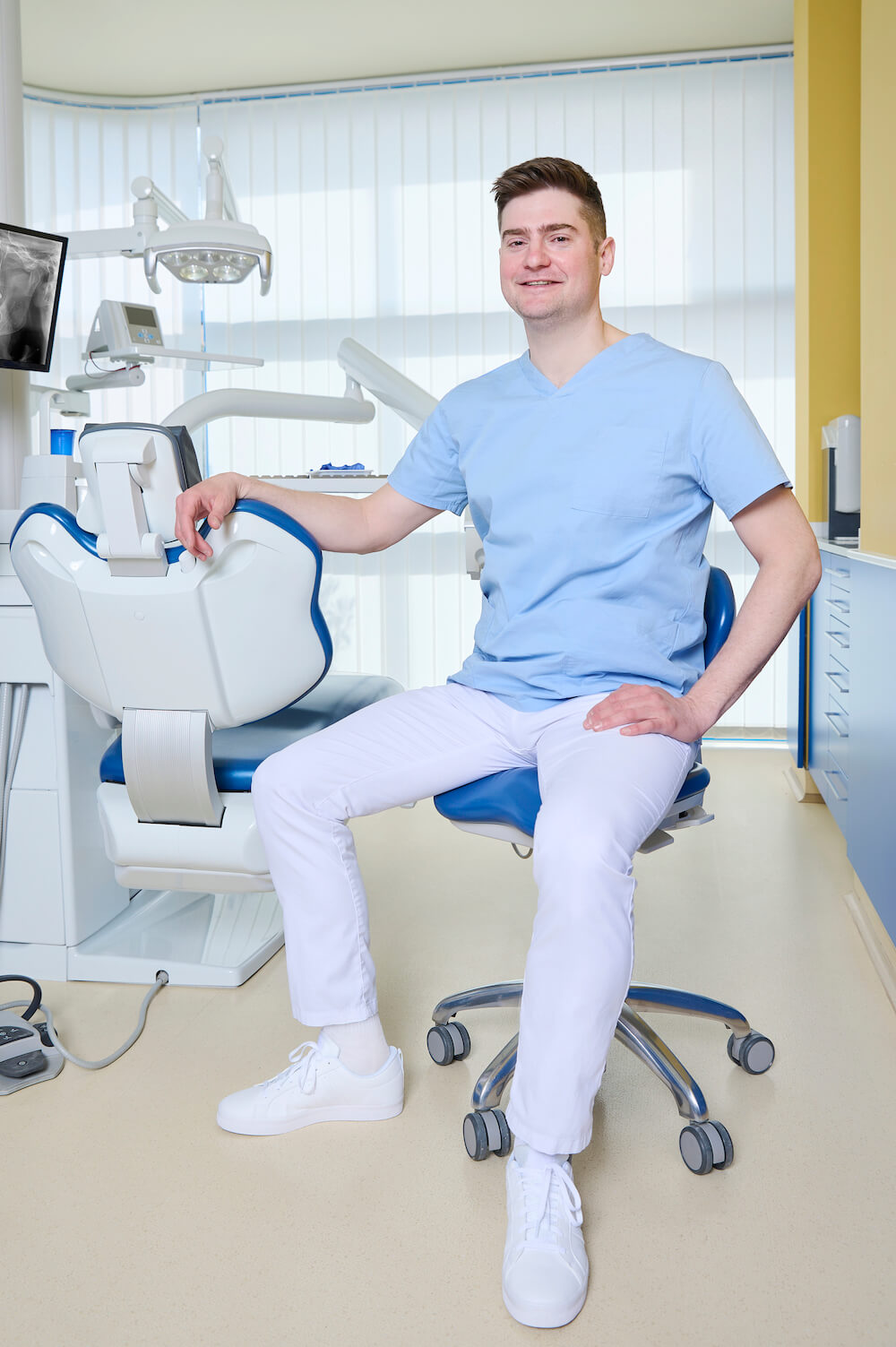
Education:
2007: Szeged University, Faculty of Dentistry
2013: Membership of ITI Danish Section (International Implantology Society)
2018: Straumann Implant Course
Ongoing: Regular annual further training courses
Speciality: General Dentistry, Dento-alveolar Surgery
Languages: Danish, English
“I chose this profession because it’s centred around people, is rooted in a desire to help, and because it’s manual, allowing me to create beautiful work. For me, it’s essential to be empathetic towards my patients. Above all, my most important professional and personal values are authenticity and quality.”

Education:
1999: Semmelweis University, Faculty of Dentistry
2001: Dental and Oral Diseases Specialisation Exam
2005: Examination in Conservative Dentistry and Prosthodontics
2018: Postgraduate Diploma of Dental Studies (Cardiff, United Kingdom)
2017: Straumann Implant Course
2018: CBCT Masterclass
Ongoing: Regular annual further training courses
Speciality: Prosthodontics, Dental Surgery (minor oral surgical procedures)
Languages: English
“From 2007 to 2019, I applied my dental expertise in Cardiff, United Kingdom. Since returning home, I’ve been utilising the knowledge I acquired at Kreativ Dental. As a proud father, I spend a significant portion of my free time with my family. Additionally, I’m heavily into sports, particularly running and swimming.”
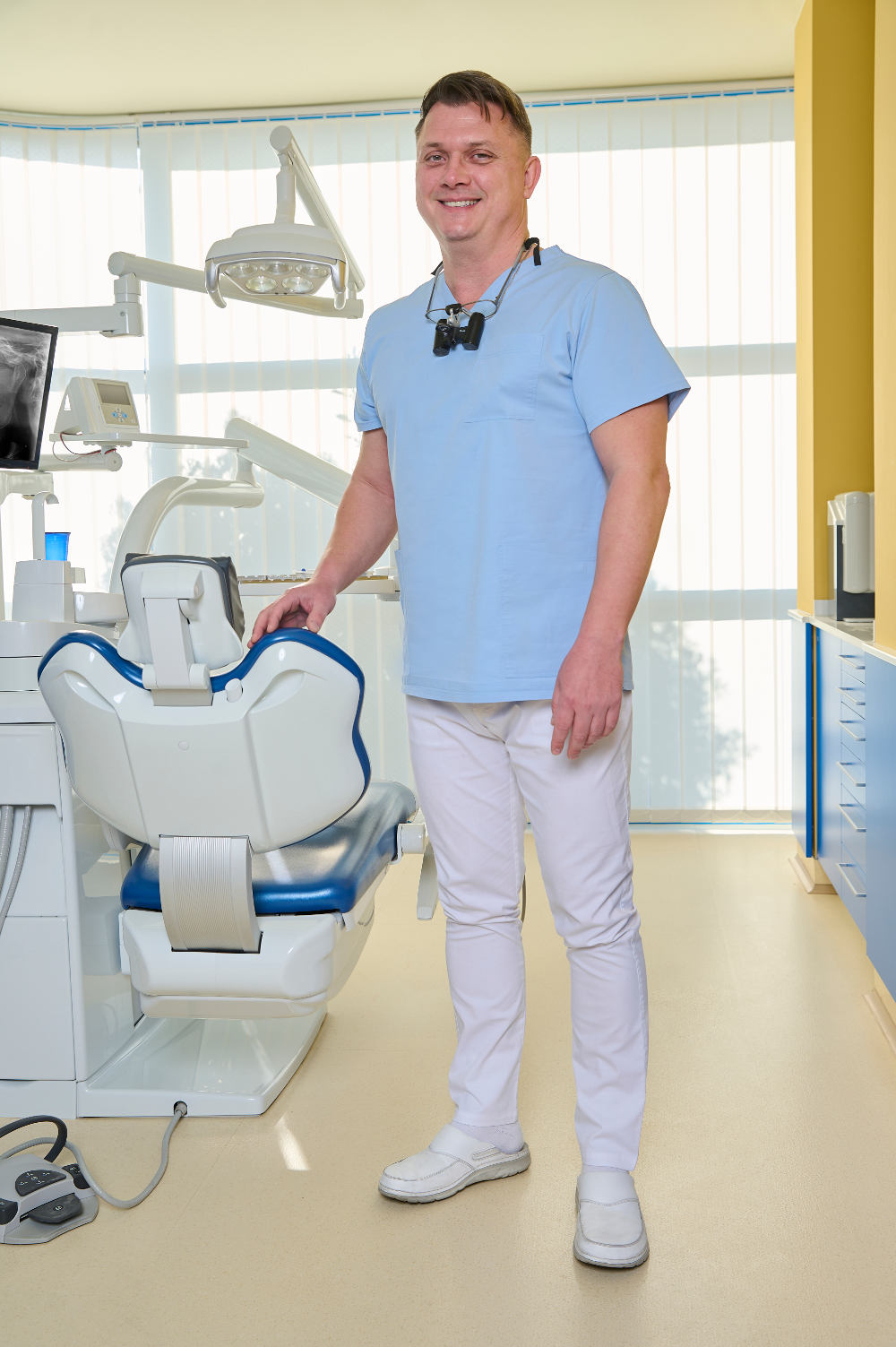
Education:
1998 University of Szeged, Faculty of Medicine
Faculty of Dentistry
2000 Examination in Dental and Oral Diseases
2007 Society for the Advancement of Anaesthesia in Dentistry (SAAD) National Course in Conscious Sedation, London, UK
2007-2008 Multi-System Implantology Certificate Course, Mr. T.C. Ucer, Trafford General Hospital, Manchester, UK – 1-year theoretical and hands-on course, UK
2008 2-year course at the Royal College of Surgeons of England Diploma in Implantology, UK
2009 Endodontic Fundamentals, University of Birmingham, Dental School, Postgraduate Office, Mr. Mike Waplington, Endodontist Specialist, UK
2009 Advanced Endodontic Course, Birmingham School of Dentistry, Postgraduate Centre, Mr. Mike Waplington, and Mr. A McRobert, Endodontist Specialists, UK
2013 Arcus Digma
Regular annual training
Specialty: Prosthodontics, fixed and removable replacements, complete dental rehabilitation with Arcus Digma digital measurement, dento-alveolar surgery
Languages: English
I spend my free time with my wife and three beautiful children.
“I believe in two things. One is family, and the other is persistent, hard work, after which I can say that I have done everything possible to maintain and improve the physical and mental health of my patients.”

Education:
2007: Semmelweis University, Faculty of Dentistry (summa cum laude)
2010: Postgraduate Specialisation
2010: Specialist in Periodontology
Ongoing: Regular annual further training courses
Speciality: Periodontology
Languages: English, German
“At university, I finished top of my class and later obtained an ‘excellent’ qualification during my postgraduate specialisation. I continually engage in both national and international further training courses to enhance and maintain my knowledge.
In my free time, I prefer spending time with my wife, who is also a dentist, and our son Áron. Additionally, I have a passion for running and exploring new places, whether it’s during a pleasant hike, as these activities help rejuvenate me and keep my life balanced. Movement plays a central role in my life; I am a regular runner and have completed half marathons 60 times.”
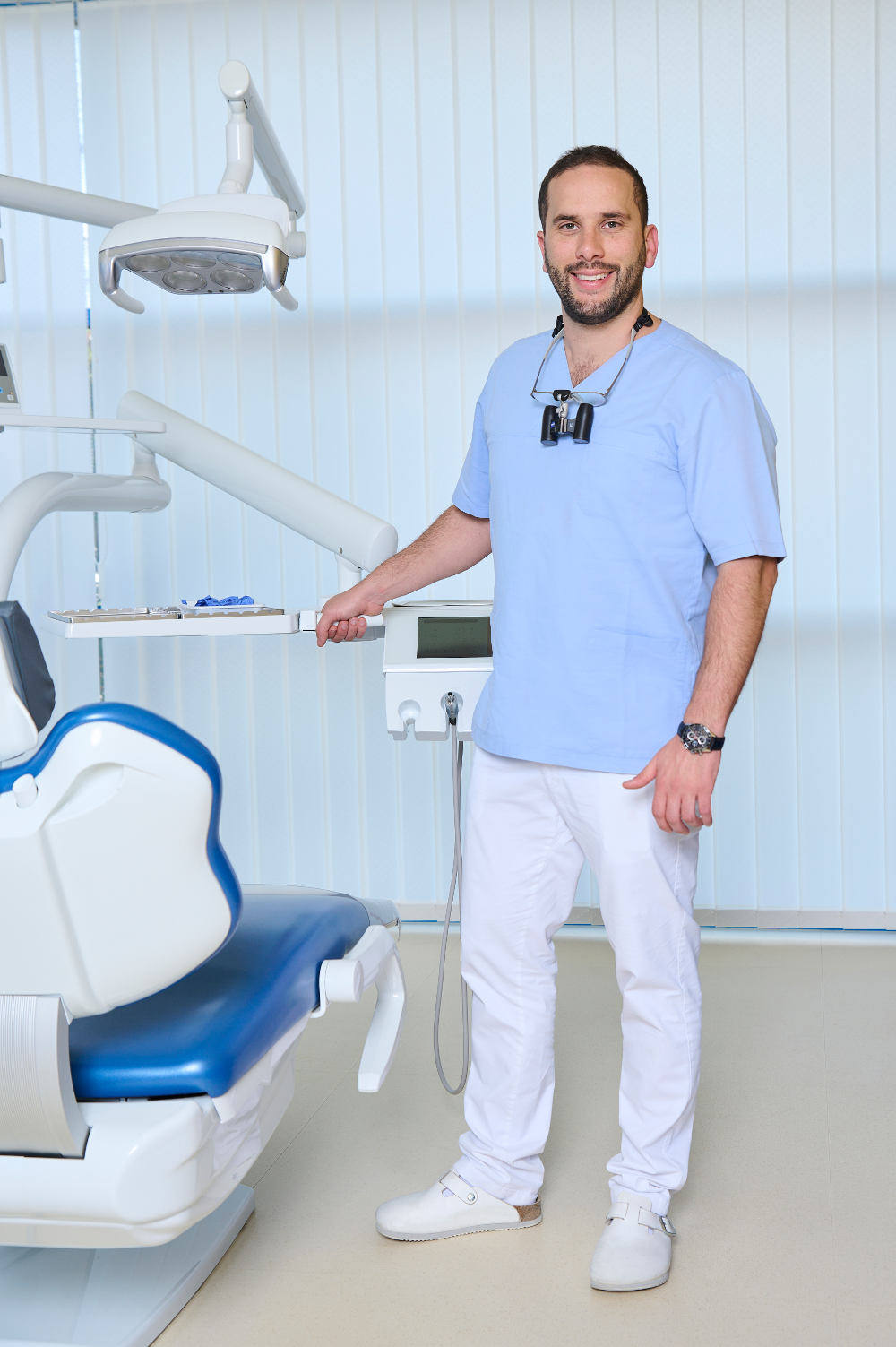
Education:
2012: Semmelweis University, Faculty of Dentistry
2015: Specialisation in Dento-alveolar Surgery
DIO Key Doctor
Ethoss Key Opinion Leader
DIO Navi Master Training
Speciality: Dento-alveolar Surgery
Languages: English
“Sport and a healthy lifestyle have always been close to my heart, so I spend my free time road cycling or sailing. For me, sailing is not just about the sport; it’s a way of life. It provides an excellent relaxation both mentally and physically.”
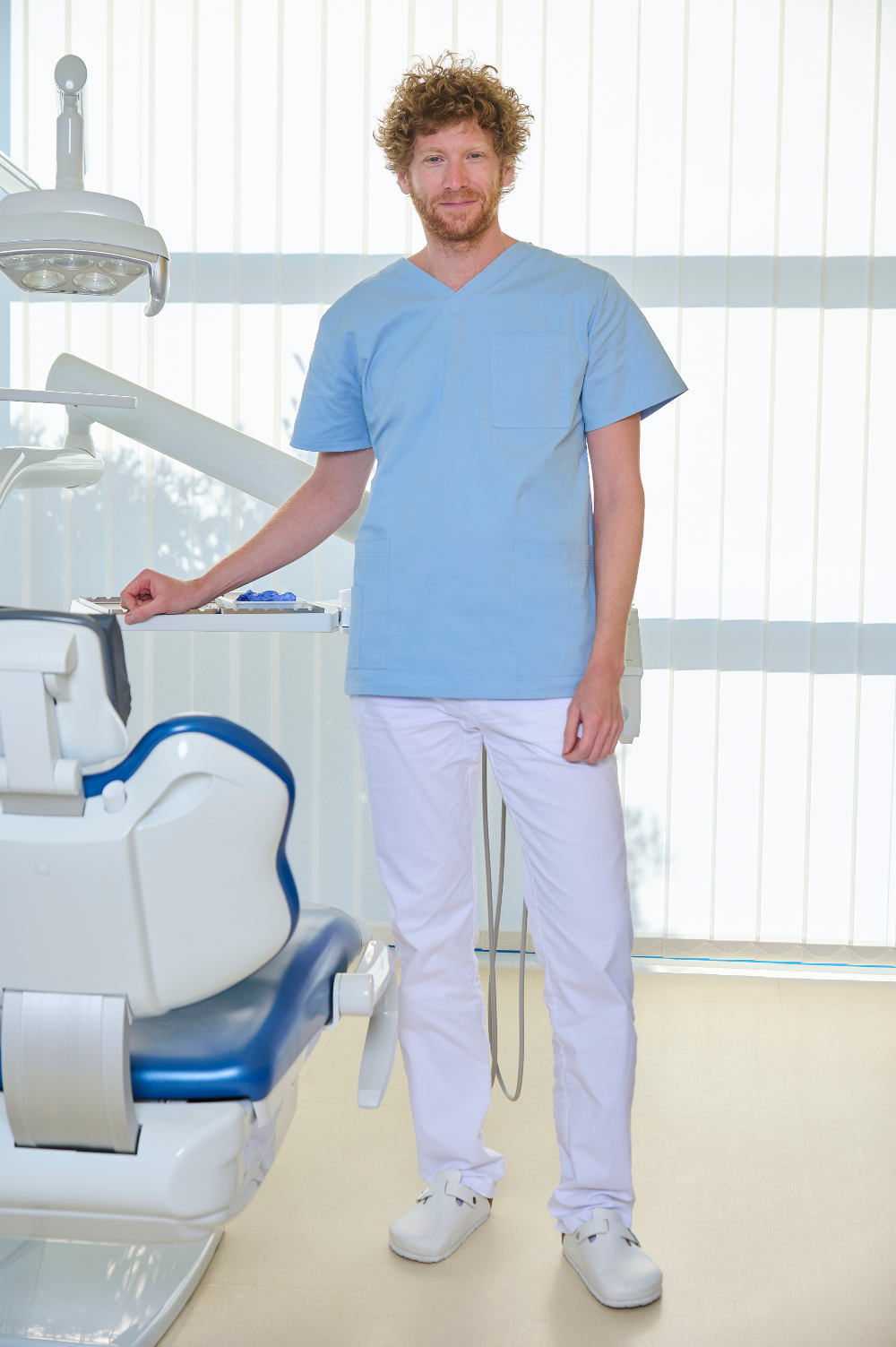
Education:
2011: Semmelweis University, Faculty of Dentistry
2014: Specialisation in Conservative Dentistry and Prosthodontics
Regular participant in domestic and international conferences
Speciality: Endodontics
Languages: English
“Gastronomy plays an essential role in my life. I regularly experiment with new recipes, dabbling with various spices and techniques to craft exciting and tasty dishes. I also have a passion for exploring new places and immersing myself in diverse cultures. For me, travelling is about broadening my horizons and collecting
memories and experiences from around the world. I am always eager for new adventures and the thrill of discovering the unknown.”
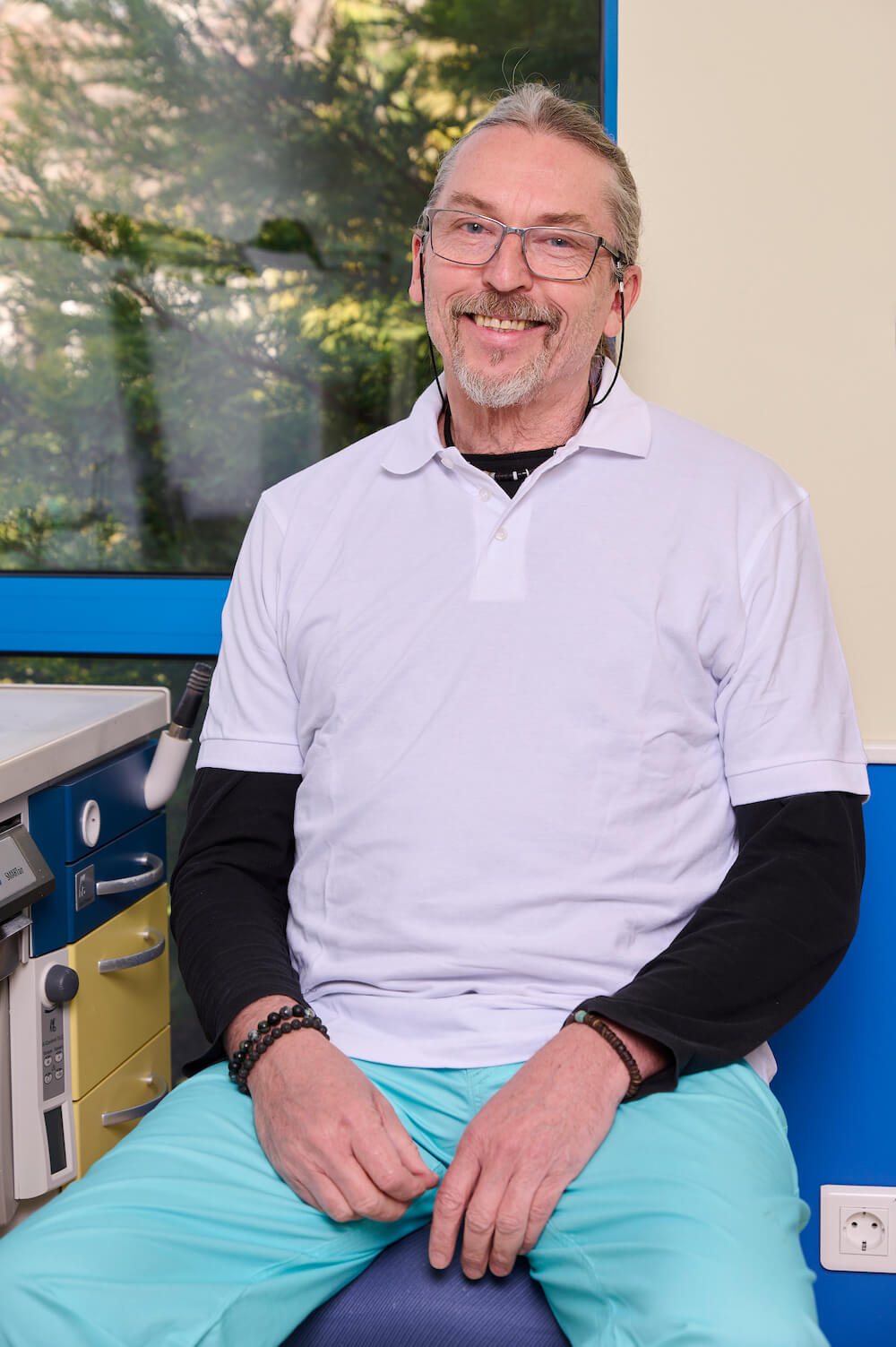
János is Leader of the Ceramic Department where all Porcelain Fused to Metal Crowns, Full Porcelain Crowns, Veneers and Inlays are skillfully crafted. Furthermore, he is one of the few exclusive demonstrators in Europe of the German company Vita which produces the best quality dental porcelain in the world.
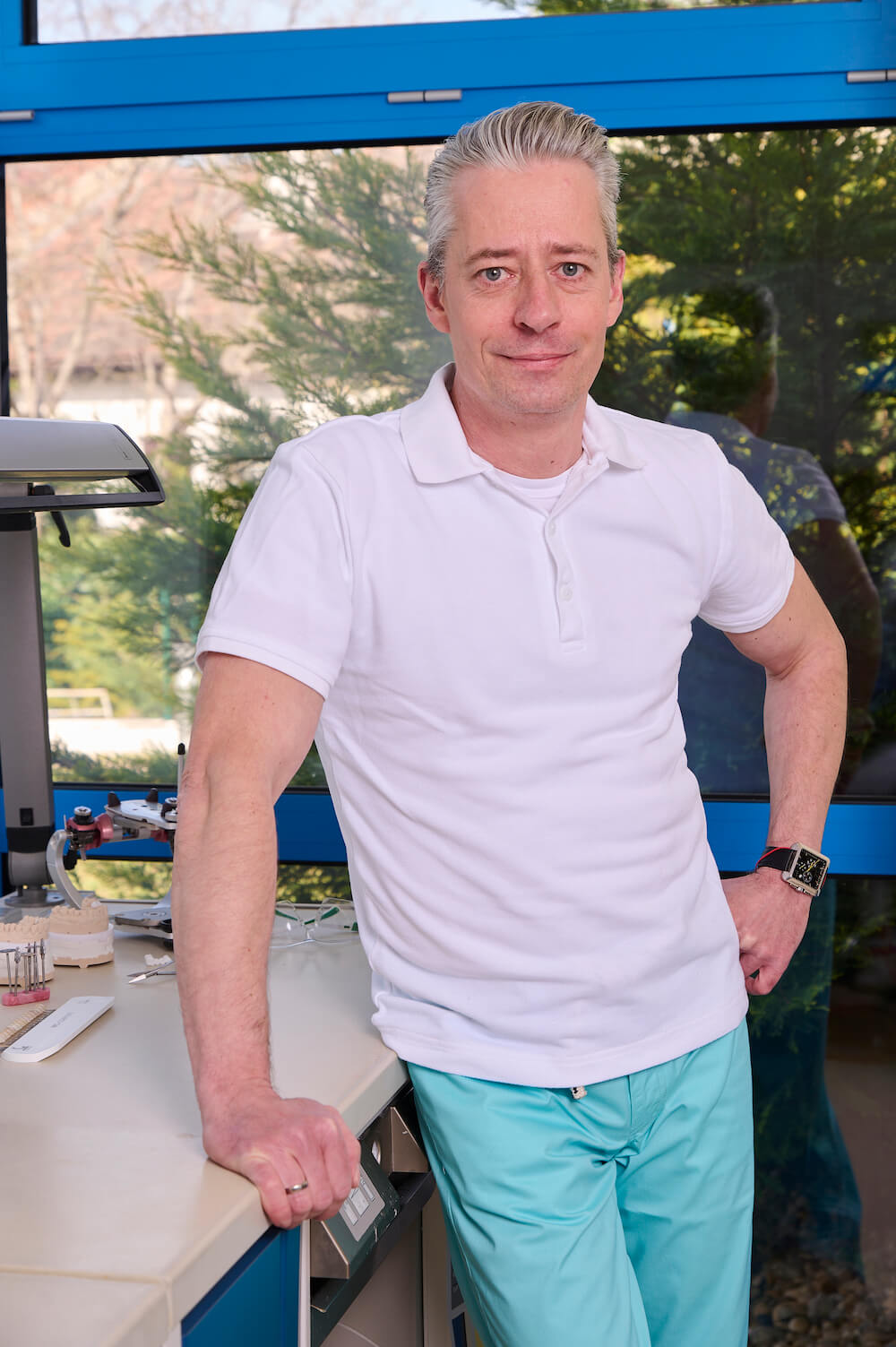
Keve Horváth joined our team of dental technicians. He works in the Ceramic Department as a master ceramist. After he graduated in 1994, he furthered his knowledge from several symposiums in Hungary, Germany and Belgium (for example Noritake and Ivoclar). In 2006 he held a course „Esthetic Front” with a real patient presence, which is a special event in Hungary and also in Europe.
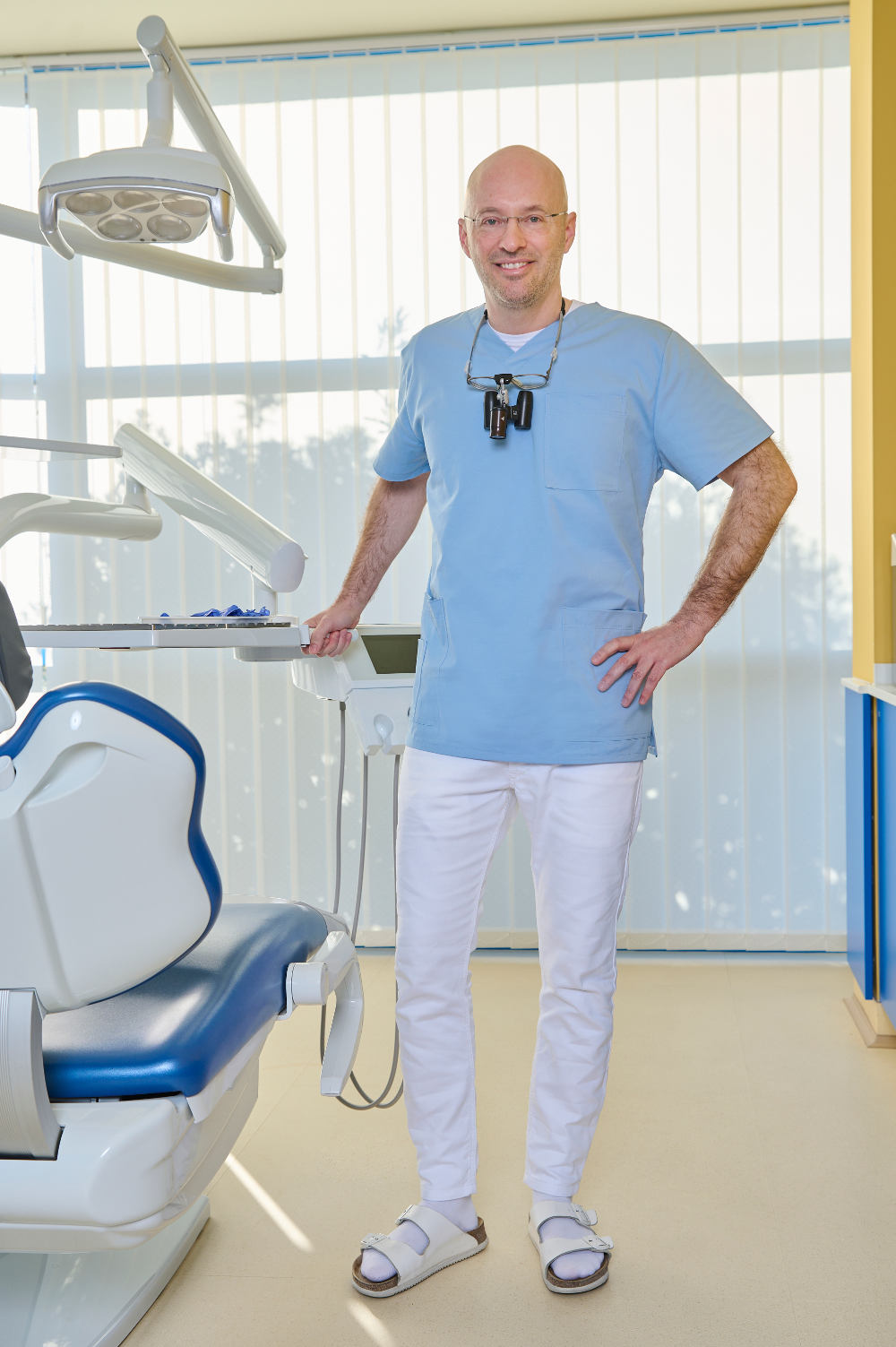
Education:
2000: Semmelweis University, Faculty of Dentistry
2002: Dental and Oral Diseases Specialisation Exam
2011: Smylist Smile Design Course
2011: Arcus Digma Training
2012: Examination in Conservative Dentistry and Prosthodontics
2013, 2015, 2017: "Competence in Esthetics" Aesthetic Dentistry Further Training
Ongoing: Regular annual further training courses
Speciality: Cosmetic Dentistry, Bite Correction with Arcus Digma Digital Measurement
Languages: English, German
“I enjoy cycling and swimming. Whenever time permits, I love to visit museums, galleries, and go to the cinema.”
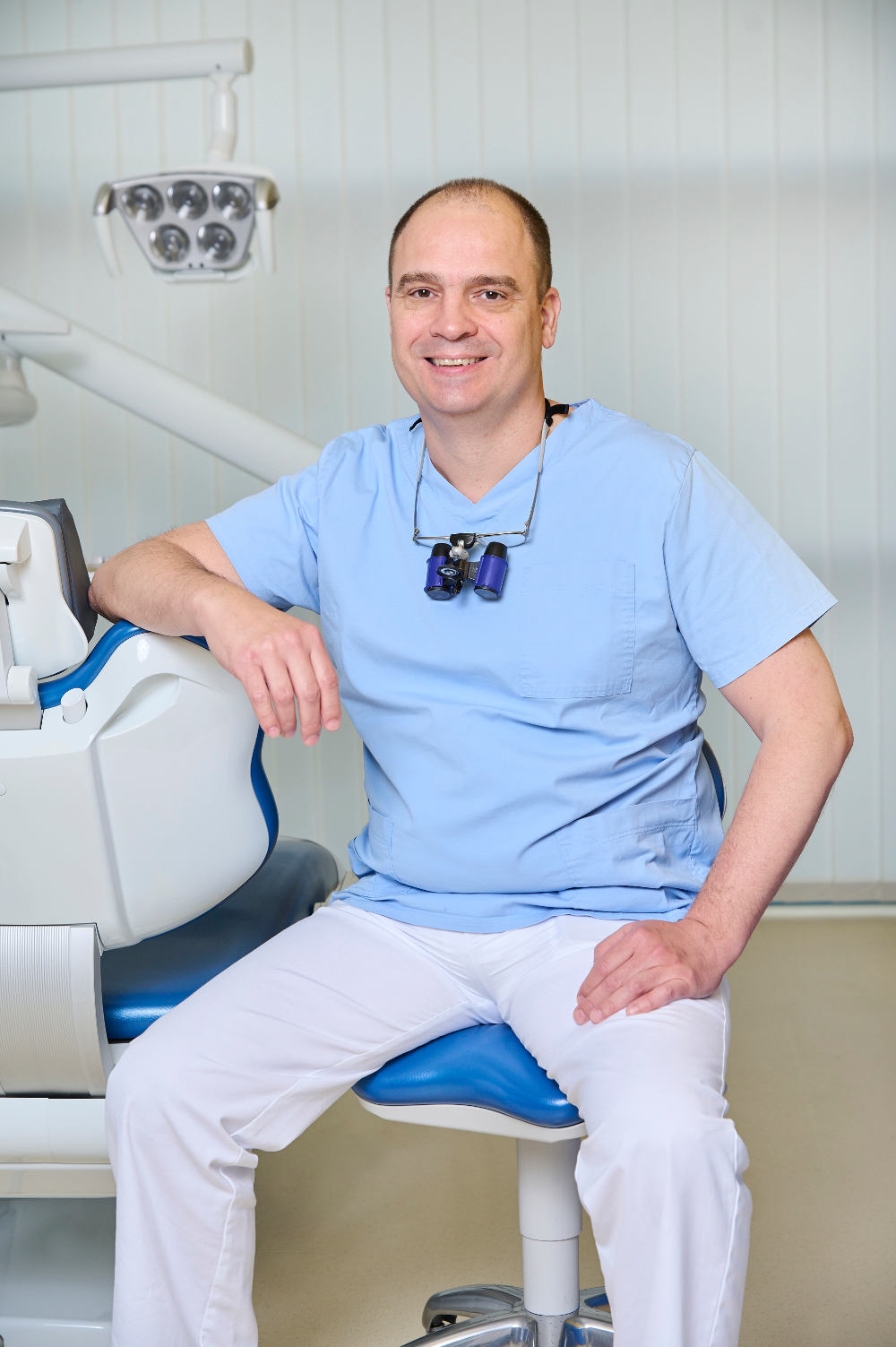
Education:
1999: Semmelweis University, Faculty of Dentistry
2001: Dental and Oral Diseases Specialisation Exam
2011: Arcus Digma
2012: Examination in Conservative Dentistry and Prosthodontics
Ongoing: Regular annual further training courses
Speciality: Fixed and Removable Dental Prosthetics, Complete Rehabilitation
Languages: English, German
“Outside of my work, my wife, children, and I particularly enjoy spending our time by the water. The closeness of nature is very calming and relaxing for all of us.”

Education:
1992: Semmelweis University, Faculty of Dentistry
1995: Dental and Oral Diseases Specialisation Exam
1996: Dento-alveolar Surgery Training
2012: Examination in Conservative Dentistry and Prosthodontics
2011: Arcus Digma
Ongoing: Regular annual further training courses
Speciality: Dental Prosthesis, Cosmetic Dentistry
Languages: English
“The most important standards for me are patient satisfaction and the utmost precision in my work.”

Education:
1986: Victor Babes University of Medicine and Pharmacy, Timișoara
1988: Târgu Mureș University of Medicine and Pharmacy, Dentistry Department
1992: Dentistry Specialisation Exam
2012: Conservative Dentistry and Prosthodontics Specialisation Exam
2011: Arcus Digma
Ongoing: Regular annual further training courses
Speciality: Cosmetic Dentistry, Implantology
Languages: Romanian, English, French
“My passion for the profession is not only reflected in my work but also in my personal life. I am proud to say that both my children now practice as dentists. In my free time, I enjoy hiking, mountain climbing, and skiing. However, my greatest joy comes from spending time with my grandchildren.”

Education:
1989: Semmelweis University, General Medical Faculty
1994: Semmelweis University, Faculty of Dentistry
1999: Dento-alveolar Surgery Specialisation Exam
2012: Maxillofacial Surgery Specialisation Exam
Ongoing: Regular annual further training courses
Speciality: Dento-alveolar Surgery, Implantology
Languages: English, German
“In addition to my daily oral surgery and dental engagements, I participate in various research projects at the Semmelweis University’s Department of Anatomy, Histology and Embryology in the Applied and Clinical Anatomy Laboratory, which focus on developing surgical solutions related to the human body.”
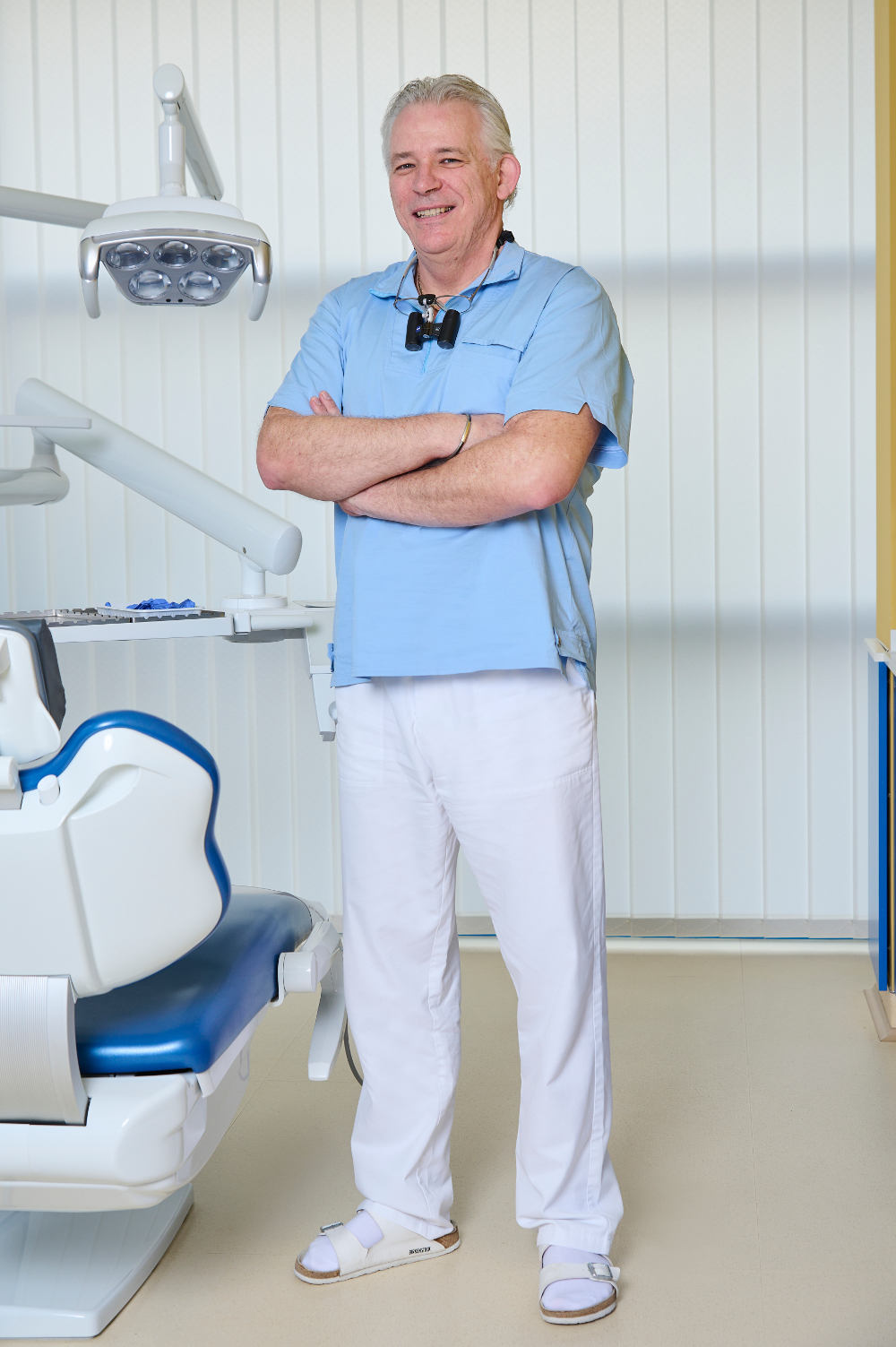
Education:
1992: Vienna Medical University (Pre-Clinical Studies)
1994: Semmelweis University, Faculty of Dentistry
1996: Dental and Oral Diseases Specialisation Exam
2008: Examination in Conservative Dentistry and Prosthodontics
2011: Arcus Digma
Ongoing: Regular annual further training courses
Speciality: Cosmetic Dentistry, Implantology
Languages: German, English
“When I can positively impact a person’s self-esteem and life by allowing them to laugh with confidence again, that’s what brings me a sense of accomplishment and satisfaction in my work. That’s why it’s worth it for me to work towards this every day.”